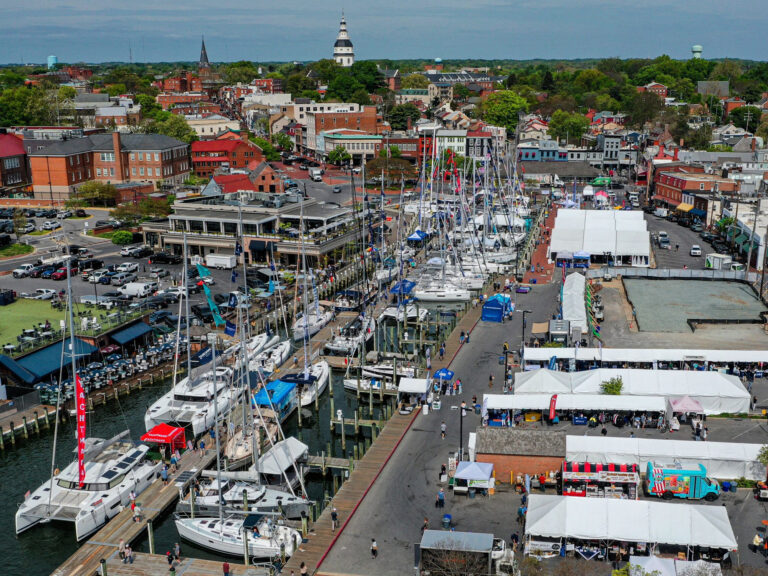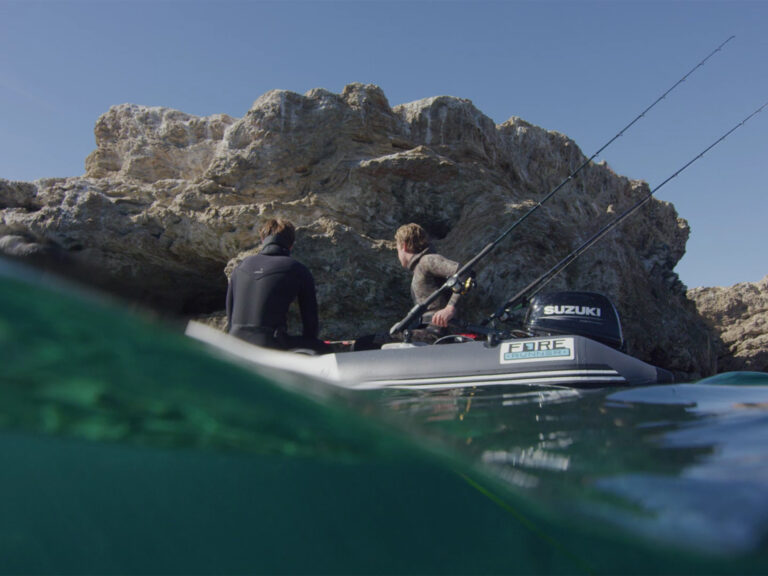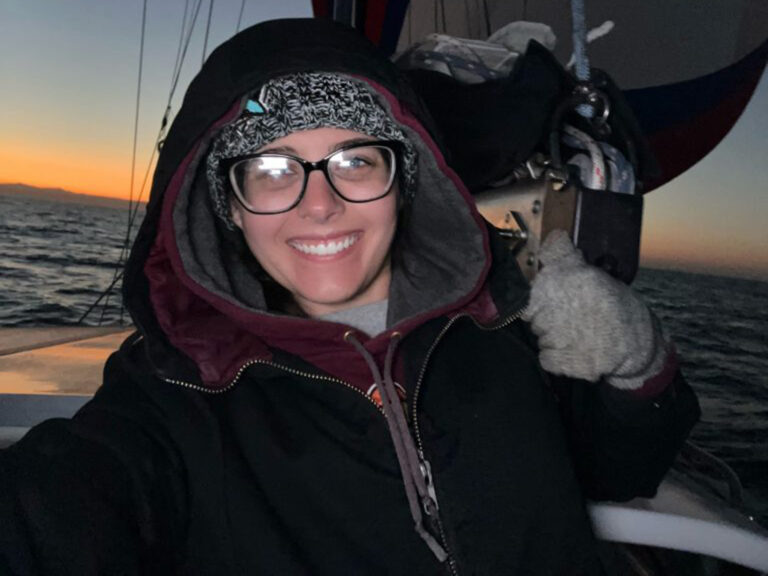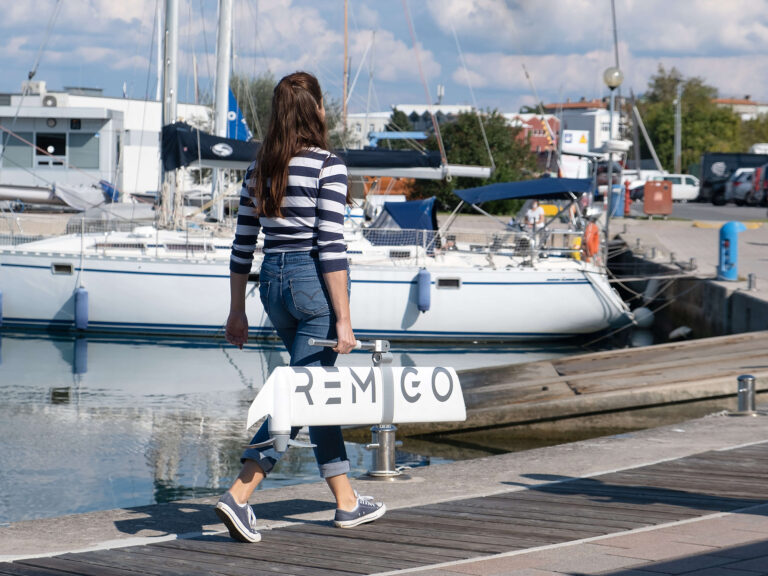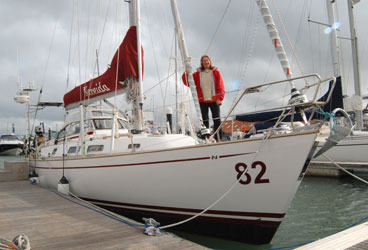
Jeanne Socrates
Of the some 260 sailors who’ve circumnavigated solo, fewer than 20 are women. Jeanne Socrates had hoped to add her name to both lists, but she was shipwrecked when she lay excruciatingly close to her goal, just 12 hours and 60 miles short of crossing her outbound track. The incredible strength she summoned to cope physically and emotionally with the trauma, together with her adaptability and forward vision in the face of adversity, are remarkable attributes that can provide motivation and inspiration to us all. Now she’s starting out again, this time to sail a solo nonstop circumnavigation around the Southern capes.
I first met Socrates in 2004. She’d shipped Nereida, her Najad 361, to Vancouver from Mexico by Dockwise Yacht Transport to participate in our British Columbia Ocean Cruising Club rally. Small, slight, and social, Socrates immediately invited Andy, my husband, and I below to share our welcoming bottle of wine.
Unlike many solo sailors, Socrates never nurtured a vision of becoming a singlehander. It wasn’t until 1990, with their children grown, that she and her husband, George, started sailing. They graduated from dinghies to cruising boats, and after they attended sailing courses, they ordered Nereida, taking delivery of her in Sweden in 1997. In 1999, after several shakedown trips, they entered the Atlantic Rally for Cruisers, sailing from the Canary Islands to the Caribbean. Like many participants they were retired and looked forward to relaxed cruising into the sunset.
It wasn’t to be. Diagnosed with terminal cancer, George could only cruise until Christmas 2002. Many presumed that Jeanne would then abandon the lifestyle, but she was back aboard Nereida in June 2003. After much soul searching, she concluded that having tasted the cruising life, staying at home had lost its appeal. Now she’d try to continue alone. Initially, she found it daunting, and she discovered that it was a huge adjustment to be unable to share the tasks and exchange ideas. She wrote later, “I soon learned to value our many boat friends and the support they give each other. The sailing is always enjoyable—but dealing with the electrics and engine caused (and still cause!) regular steep learning curves.”
Soon after rejoining Nereida, she read about our Vancouver rally and decided that this was the stimulus needed to leave the Caribbean. In the Pacific Northwest, she could continue to build new skills and further her knowledge in the company of an accomplished group of sailors. To be a member of the Ocean Cruising Club, an international organization administered from the United Kingdom, a person must sail at least 1,000 miles nonstop offshore. Cruisers were coming from around the world for this event, many in their own boats.
Inspired by rally participants, she finally felt ready to take the plunge and sail Nereida solo offshore. It was October, late in the season, when she headed down the infamous Washington and Oregon coasts, calling the trip “the big test.” To her surprise, she was exhilarated by the offshore solo experience and spent an enjoyable winter sailing to Zihuatanejo, Mexico, before shipping the boat north again, this time to Ketchikan, Alaska, to explore the dramatic and remote Inside Passage there. I joined her in Glacier Bay for a spectacular week as Nereida, dwarfed by towering mountains, sailed in between surreal-shaped icebergs and anchored near aqua glaciers. En route I learned that Socrates, an avid birdwatcher, was as enthusiastic as I am about researching and exploring new destinations and the wonders of wildlife.
I became aware of her constant attention to detail in boat operation, in updating the logbook, and in the preparation for docking and anchoring that’s required when one does it alone. She sailed south again in the spring of 2006 and in San Francisco heard of the Singlehanded Sailing Society’s Singlehanded TransPac Race, which she entered, reserving last-place position for herself. However, she wasn’t last to finish, and she found the event a stimulating learning experience and confidence booster.
It was at this time that she began making plans to circumnavigate alone. After sailing Nereida to Sitka, Alaska, where she had to spend time rebuilding the engine (under supervision and instruction, she notes), Socrates headed back down to Zihuatanejo, and on March 26, 2007, she started her trip around the world. Her plan was to complete it in a year if possible, but she wanted to remain flexible enough to enjoy some sightseeing along the way.
Over the next 15 months, Socrates island-hopped across the South Pacific to Australia, then sailed to Bali, part of Indonesia. She again island-hopped across the Indian Ocean to Richards Bay, South Africa, before rounding the Cape of Good Hope, then crossing from the South Atlantic to the North Atlantic.
Every landfall was a new destination. Socrates reached Trinidad 13 months later. She tells of an enjoyable, exciting time, and although there were plenty of testing situations, she had huge confidence in Nereida‘s ability. The boat was easy to handle, steady in big seas, and sailed well both upwind and down. After a delay while transiting the Panama Canal, Socrates was glad to be under way on her last leg, one that she knew would require substantial motoring, since the Pacific coast of Central America is notorious for its fickle winds.
If the conditions prevailed and the engine held strong, Socrates knew that she’d reach Zihuatanejo by the evening of June 19, where a welcoming party was planned. Instead, just 12 hours and 60 miles short of the completion of Socrates’ solo circumnavigation, Nereida lay helpless, grounded on remote Playa Michigan, and Socrates was being dragged under water by the strong ebb of the spring tide while setting anchors to stop Nereida from slamming on the steep shore.
Recalling the moment of impact brings from Socrates a torrent of emotion—the sense of unreality, the despair, the disbelief that in such calm conditions, with so little wind or swell, under a starry sky and full moon this was happening, that her boat was being pounded to pieces stranded inside the breakers of the surf line after 25,500 miles at sea. Socrates described her urge to minimize damage to the boat in the hope that there might be someone who could tow her off. Calls on the radio, setting off the EPIRB, assistance from the local captain of the marines, and a trip to Acapulco raised no such craft. With Nereida holed and filling with sand and water, Socrates was faced with the sickening realization that her boat was doomed and that all she could do was remove equipment and personal possessions as quickly as possible.
She explained the enormity of her loss to the surprised locals: “Es mi casita, mi vida.” “It’s my home, my life.” With their help, considerable equipment was salvaged over the next few days, which a fellow cruiser later collected on his way north. Socrates gave many gifts to her helpers and says that most of them couldn’t have been kinder, although, of course, there inevitably were some vultures. What bothered her more was the saturation and loss of all her address and telephone records and, particularly, all the logbooks in which she’d recorded details so painstakingly.
Fortunately, she still had the recorded daily positions on passage sent to the Winlink website and the information that she’d uploaded to her website. A data-recovery firm retrieved most of her photos from her laptop hard drive. She was also able to diagnose that the reason for the grounding was battery failure in the remote autopilot control, which caused the autopilot to go into standby mode when it ran out of charge. She’d been aware of the problem and had plugged the unit into recharge the night before; perhaps it came loose, she later thought. Because of the calm conditions, there was no change in motion to awaken her as the boat altered course while she catnapped.
Many would’ve gone home to recover and reanalyze life after the intense trauma and hard physical work. Not so Socrates. She decided to continue her former plans in other ways. She flew to Hawai’i to greet friends at the TransPac finish, then joined the second O.C.C. rally in B.C. with us on our boat, Bagheera. She visited England’s Southampton boat show to order equipment for her new boat, a Najad 380. Fortunately, Nereida was insured, and Socrates wasn’t ready to call it quits. The cruising world was too exhilarating a lifestyle to abandon.
Although ordering the boat could’ve been an impulsive reaction, Socrates was well aware of the enormity of her decision and understood the complexity of creating a vessel that would work for her. She looked exhausted when we connected later at the London boat show, admitting to moments of panic. With long lists in hand, she’d been visiting a number of exhibitors. Not that she’s buying every modern gadget. When I asked her, for example, if she was planning to add an electric winch, she smiled. She wasn’t ready for that yet!
Now, 18 months later, she’s already sailed 23,000 nautical miles, putting her vessel to the test. She’s experienced some frustrating delays, in particular one caused by an engine replacement in South Africa due to flooding sustained during considerable heavy weather, but now she’s ready to rise to the challenge of a solo nonstop circumnavigation starting in Victoria, British Columbia. Tony Gooch, himself a solo nonstop circumnavigator, will be her official starting commissioner, and she’ll carry a black box provided by the World Speed Record Council for route verification; it’s the one carried by Alessandro Di Benedetto, recently the record setter aboard his 21-footer for circumnavigating in the smallest boat.
As I work the boat-show trail, many sailors lament to me about best-laid cruising plans going awry. The typical culprits include illness, reticent partners, dependent relatives, and the current state of the economy. Getting back on track for them seems a slim reality. And yet we learn from Socrates that new strength can come from adversity and the energy used to adapt the dream in a workable way.
Plans can be changed, Socrates shows us, and aspirations modified. It may mean a smaller boat and less equipment, or extending local cruising rather than voyaging overseas. If one is sailing offshore, cruising in stages may be the best option for those who need to return to work or have health issues; such sailors could haul the boat at one of the many new marinas worldwide. Working the seasons is a bonus within this regime and serves well for those missing their families. Earmarking funds for enhanced communication while you’re away and keeping an Internet profile both entertain and give security to those left behind. Economical countries can be chosen rather than the typical, and often more expensive, ones along the routine routes.
Planning and communications can make such a difference: Advance research into local cultures, sights, wildlife, fauna, and food as well as safe anchorages and marinas goes a long way toward ensuring that everyone aboard is content. So too is participating in the many radio nets to keep in touch with the superbly supportive community of cruisers worldwide.
Jeanne Socrates shows cruising sailors the world over that with energy and commitment, setbacks can be overcome and even the very dreams themselves can be adapted.
Circumnavigator and author Liza Copeland is a regular contributor to CW.




